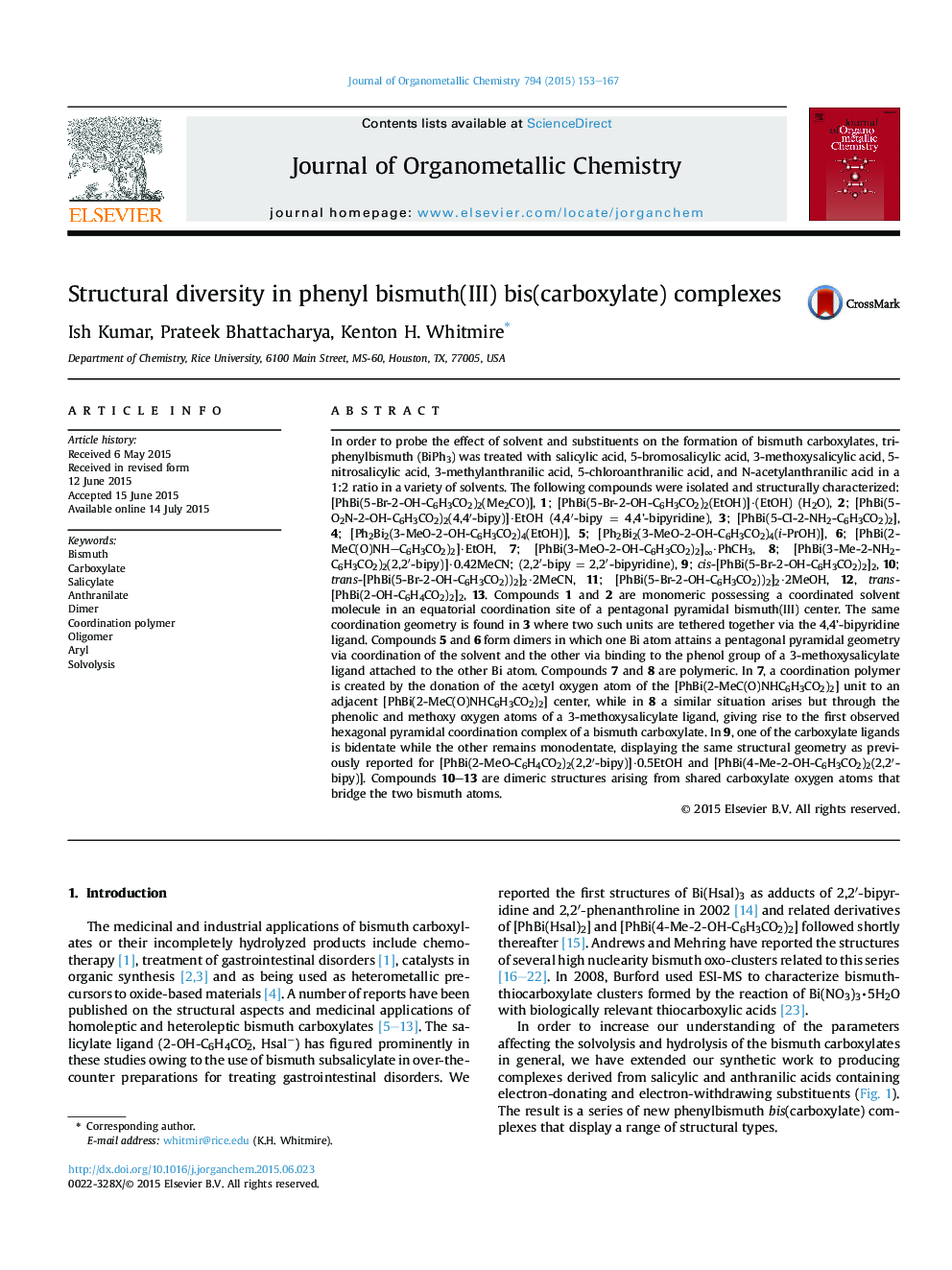| کد مقاله | کد نشریه | سال انتشار | مقاله انگلیسی | نسخه تمام متن |
|---|---|---|---|---|
| 1320801 | 1499849 | 2015 | 15 صفحه PDF | دانلود رایگان |

• 13 new phenyl bismuth bis(carboxylate) compounds have been prepared.
• New structural types have been observed including the hexagonal pyramid.
• Dimeric structures are observed in both cis and trans forms.
• Both dimeric forms may also show solvent coordination.
• Coordination polymers are created by binding of substituents on the aryl ligands.
In order to probe the effect of solvent and substituents on the formation of bismuth carboxylates, triphenylbismuth (BiPh3) was treated with salicylic acid, 5-bromosalicylic acid, 3-methoxysalicylic acid, 5-nitrosalicylic acid, 3-methylanthranilic acid, 5-chloroanthranilic acid, and N-acetylanthranilic acid in a 1:2 ratio in a variety of solvents. The following compounds were isolated and structurally characterized: [PhBi(5-Br-2-OH-C6H3CO2)2(Me2CO)], 1; [PhBi(5-Br-2-OH-C6H3CO2)2(EtOH)]·(EtOH) (H2O), 2; [PhBi(5-O2N-2-OH-C6H3CO2)2(4,4′-bipy)]·EtOH (4,4′-bipy = 4,4’-bipyridine), 3; [PhBi(5-Cl-2-NH2-C6H3CO2)2], 4; [Ph2Bi2(3-MeO-2-OH-C6H3CO2)4(EtOH)], 5; [Ph2Bi2(3-MeO-2-OH-C6H3CO2)4(i-PrOH)], 6; [PhBi(2-MeC(O)NH–C6H3CO2)2]·EtOH, 7; [PhBi(3-MeO-2-OH-C6H3CO2)2]∞·PhCH3, 8; [PhBi(3-Me-2-NH2-C6H3CO2)2(2,2′-bipy)]·0.42MeCN; (2,2′-bipy = 2,2′-bipyridine), 9; cis-[PhBi(5-Br-2-OH-C6H3CO2)2]2, 10; trans-[PhBi(5-Br-2-OH-C6H3CO2))2]2·2MeCN, 11; [PhBi(5-Br-2-OH-C6H3CO2))2]2·2MeOH, 12, trans- [PhBi(2-OH-C6H4CO2)2]2, 13. Compounds 1 and 2 are monomeric possessing a coordinated solvent molecule in an equatorial coordination site of a pentagonal pyramidal bismuth(III) center. The same coordination geometry is found in 3 where two such units are tethered together via the 4,4’-bipyridine ligand. Compounds 5 and 6 form dimers in which one Bi atom attains a pentagonal pyramidal geometry via coordination of the solvent and the other via binding to the phenol group of a 3-methoxysalicylate ligand attached to the other Bi atom. Compounds 7 and 8 are polymeric. In 7, a coordination polymer is created by the donation of the acetyl oxygen atom of the [PhBi(2-MeC(O)NHC6H3CO2)2] unit to an adjacent [PhBi(2-MeC(O)NHC6H3CO2)2] center, while in 8 a similar situation arises but through the phenolic and methoxy oxygen atoms of a 3-methoxysalicylate ligand, giving rise to the first observed hexagonal pyramidal coordination complex of a bismuth carboxylate. In 9, one of the carboxylate ligands is bidentate while the other remains monodentate, displaying the same structural geometry as previously reported for [PhBi(2-MeO-C6H4CO2)2(2,2′-bipy)]·0.5EtOH and [PhBi(4-Me-2-OH-C6H3CO2)2(2,2′-bipy)]. Compounds 10–13 are dimeric structures arising from shared carboxylate oxygen atoms that bridge the two bismuth atoms.
Triphenylbismuth reacts with substituted aryl carboxylates cleanly to yield crystalline PhBi(O2CR)2 (R = OH-2-C6H4, Br-5-C6H4, 5-O2N-2-OH-C6H3, 3-MeO-2-OH-C6H3, 3-Me-2-NH2-C6H3, 2-MeC(O)NH–C6H3) at room temperature in a variety of solvents. The products show a surprising diversity in structural motifs including solvated monomers, symmetrical dimers that may either be solvated or unsolvated, asymmetric dimers and polymers. The dimers may exist in cis or trans configurations. The observed products are strongly solvent dependent.Figure optionsDownload as PowerPoint slide
Journal: Journal of Organometallic Chemistry - Volume 794, 1 October 2015, Pages 153–167